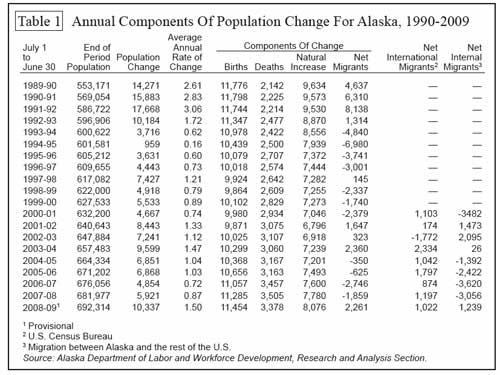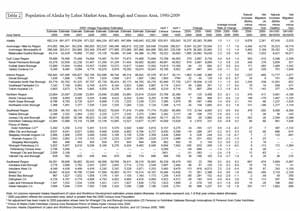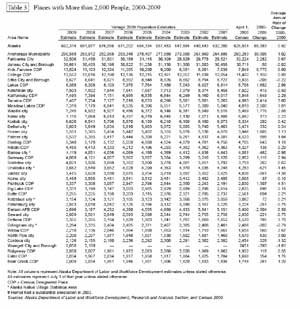 Ketchikan, flat or declining population growth January 28, 2010
The number of people living in Alaska climbed from 627,533 in 2000 to 692,314 in 2009 (See Table 1).  Table courtesy Alaska Department of Labor & Work Force Development
Currently, Alaska's growth as a whole is primarily through natural increase. From 2000 to 2009, Alaska's natural increase (births minus deaths) added 66,149 people, while net-migration (in-migration minus out-migration) accounted for a loss of 1,368 people. During 2008- 2009, Alaska added 8,076 people through natural increase and 2,261 people through net in-migration. When international and domestic migration are considered separately, the gain of 2,261 migrants between 2008 and 2009 breaks down to a gain of 1,239 domestic migrants and 1,022 international migrants. Thus, domestic migration is currently the larger contributor for inward migration. About 92,200 people now migrate to and from Alaska each year. In and out-migration are nearly equal at about 47,200 in and 45,000 out. "In 2008-2009 we observed a positive net-migration into the state (+2,261), which hasn't occurred since 2003- 2004. This increase in migrants can be explained by the increase in military movement into Anchorage. It is important to note that, because our estimates are for resident population, any troops deployed overseas are counted as being in Alaska in our estimates," said Greg Williams, State Demographer. "This means that the populations for the Fairbanks North Star Borough and the Municipality of Anchorage, where the main Alaska military bases are located, as well as other communities with a substantial National Guard presence, may be somewhat lower than these estimates indicate, depending on the current deployment of military and National Guard personnel." Boroughs and Census Areas Department of Labor population estimates have also been released for Alaska's 29 boroughs and census areas (see Table 2), as well as for 346 places located throughout the state. Unlike Table 1, which considers population change from the average annual population in 2000, Table 2 (and the remainder of this report) considers population change from the April 1, 2000 U.S. Census.
Most of Alaska's boroughs and census areas grew slowly or lost population between the 2000 Census and 2009. Of the 29 boroughs and census areas, only 11 gained population between 2000 and 2009. The largest population increases occurred in the Municipality of Anchorage (+30,305), Matanuska-Susitna Borough (+24,992), Fairbanks North Star Borough (+10,939), Kenai Peninsula Borough (+3,887), Southeast Fairbanks Census Area (+1,069), Bethel Census Area (+951) and Wade Hampton Census Area (+666). Population growth in the Municipality of Anchorage and the Mat-Su Borough accounted for roughly 75.4 percent of the growth in those 11 boroughs and census areas. The Municipality of Anchorage made up 41.3 percent of the growth, with population gains in the Mat-Su Borough making up 34.1 percent. The Mat-Su Borough continued in 2009 to be the fastest-growing area in the state, as it has been since 1990. Between 2000 and 2009, it grew at an average annual rate of 3.8 percent, the same annual growth rate during the 1990s. However, its growth slowed to 2.3 percent between 2008 and 2009. The Mat-Su Borough was the only area of the state where growth came primarily from net in-migration. Since the 2000 Census, net in-migration accounted for 18,571 or 74.3% of the Mat-Su Borough's population increase of 24,992. The 2000-2009 areas that grew through net migration were Mat-Su Borough (+18,571), Municipality of Anchorage (+1,203), Kenai Peninsula Borough (+831) and Southeast Fairbanks Census Area (+471). These were the only areas where in-migration noticeably exceeded out-migration during 2000-2009. Eighteen boroughs and census areas lost population between 2000 and 2009. The Southeast region continued to have the largest overall decline, losing 5.1 percent of its population since 2000, with a natural increase of 4,560 people and a net out-migration of 8,304 people. No Southeast borough or census area had long-term growth between 2000 and 2009. In the 2008-2009 period, Juneau (+256), Yakutat (+36), Prince of Wales-Outer Ketchikan (+34), Skagway (+19) and Ketchikan Gateway (+4) had small population gains. In all the rest of the Southeast area, out-migration was greater than natural increase. This trend is due, in part, to an older population in the region. Between 2000 and 2009, net out-migration from Southwest Alaska (-5,867) was only slightly less than the natural increase in the region (+5,889). The Southwest areas that increased were the Bethel Census Area (+951), Wade Hampton Census Area (+666) and Aleutians East Borough (+81). In every other area of Southwest, net out-migration exceeded natural increase or broke even. In the Northern region, natural increase (+3,981) failed to keep up with out-migration (-4,106). The greatest loss was in North Slope Borough where out-migration (-1,824) substantially exceeded natural increase (+1,237). Nome and Northwest Arctic Borough had a natural increase that was slightly higher than out-migration. In the Gulf Coast region, natural increase (+5,246) kept ahead of out-migration (-2,359) between 2000 and 2009. The Kodiak Island Borough had more net out-migration (-1,542) than natural increase (+1,489) and the Valdez- Cordova Census Area declined as natural increase (+701) failed to match net out-migration (-1,648). The Kenai Peninsula Borough grew mainly through natural increase (+3,056) as opposed to net-migration (+831). During the 2008-2009 period,
the Valdez-Cordova Census Area declined as net out-migration
(-329) exceeded natural increase (+82). In the Kenai Peninsula
Borough, however, both natural increase (+340) and net-migration
(+279) were positive. The Kodiak Island Borough lost because
natural increase (+171) was less than out-migration (-265). During the 2008-2009 period, only Yukon-Koyukuk Census Area (-70) had population losses in the Interior Region. Fairbanks North Star Borough (+1,017), Southeast Fairbanks Census Area (+84) and Denali Borough (+32) all had gains. Places Alaska had 36 places with populations of more than 2,000 in the year 2000 (see Table 3); 23 of them were incorporated cities or city-boroughs in 2009. Forty-one places in Alaska had populations of more than 2,000 in 2009.
The Municipality of Anchorage continued to dominate the state. Its population of 290,588 in 2009 accounted for 42.0 percent of the state's population, up slightly from 41.5 percent in 2000. The Anchorage/Mat-Su region (374,902) accounted for 54.2 percent of Alaska's population in 2009, up from 51.0 percent in 2000. The 14 places with populations greater than 2,000 that have had average annual growth rates above 2.0 percent since the 2000 Census include the Knik-Fairview Census Designated Place, or CDP, (+6.0 percent), Fishhook CDP (+4.5 percent), Meadow Lakes CDP (+3.8 percent), Deltana CDP (+3.7 percent), Tanaina CDP (+3.6 percent), Homer city (+3.1 percent), North Pole city (+3.1 percent), Gateway CDP (+2.9 percent), Willow CDP (+2.7 percent), Wasilla city (+2.6 percent), Kalifornsky CDP (+2.3 percent), Butte CDP (+2.2 percent), Big Lake CDP (+2.2 percent) and Lakes CDP (+2.1 percent). Ten of the top 14 places that experienced the most rapid growth between 2000 and 2008 are in the Mat-Su Borough. Indeed, if they were to incorporate, four places in the Mat-Su Borough would be larger than Wasilla city. Knik-Fairview would become the fourth-largest city in the state. Of the remaining four rapidly growing places, the Kalifornsky CDP and Homer city are in the Kenai Peninsula Borough, Deltana CDP is in the Southeast Fairbanks Census Area and North Pole city is in Fairbanks North Star Borough. Homer's growth is largely due to its annexation of a substantial part of Diamond Ridge CDP and Miller Landing CDP in 2002. "Outside the Anchorage/Mat-Su region, a majority of communities have flat or declining population growth ," Williams said. "Thirteen of the places that had more than 2,000 people in 2000 have since declined. In fact, 192 (54.5 percent) of the 352 places in Alaska have had either zero gains or population losses since the 2000 Census. That includes five of the largest communities: the Juneau city and borough, Sitka city and borough, Ketchikan city, Kodiak city and Barrow city." The larger places that declined
an average by more than 1.0 percent each year during the 2000-2009
period were Eielson Air Force Base CDP (-5.6 percent), Wrangell
City and Borough (-1.6 percent), Unalaska city (-1.5 percent),
Valdez city (-1.4 percent), Cordova city (-1.3 percent) and Barrow
city (-1.0 percent). Source of News & Tables:
Publish A Letter in SitNews Read Letters/Opinions
|
|||

